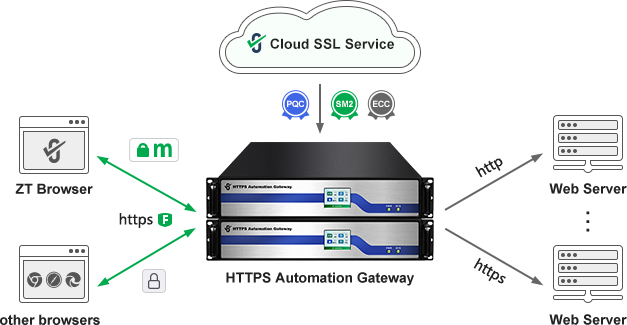About the UI displaying the HTTPS cryptographic algorithm
Whether a website is secure depends on at least four fundamental factors: HTTPS encryption, cryptography algorithm, WAF protection, and trusted identity validation. This is why ZT Browser's UI innovation displays four security-related icons:
. In addition to the security padlock, it also displays the cryptographic algorithm, WAF protection, and website trusted identity validation level. Please refer to the innovation UI Icon Summary of ZT Browser for details.
The authentication algorithm used by HTTPS encryption depends on the cryptographic algorithm used to issue the SSL certificate deployed by the website, while the actual encryption algorithm is negotiated and determined by the browser and the web server. ZT Browser supports four cryptographic algorithms: RSA, ECC, SM2, and PQC. Different algorithms display different icons, allowing users to identify whether website data is quantum-safe and supports China commercial cryptographic algorithms. This also allows government regulators and cryptographic audit agencies to intuitively understand whether the SSL certificate deployed by the website complies with China Cryptography Law. If a website deploys a dual-algorithm SSL certificate, such as RSA+SM2, ZT Browser will prioritize the SM2 algorithm for HTTPS encryption to meet the user's commercial cryptography compliance requirements. If a website deploys an RSA/ECC/SM2 algorithm SSL certificate but supports the post-quantum cryptographic key encapsulation protocol, the post-quantum cryptographic protocol will be prioritized for HTTPS encryption. If a website deploys SSL certificates with RSA/ECC/SM2/PQC algorithms simultaneously, ZT Browser will prioritize the PQC algorithm for HTTPS encryption.
The specific UI display rules are as follows:
1. If the website deploys an RSA/ECC/SM2 algorithm SSL certificate and supports PQC key encapsulation to implement PQC HTTPS encryption, or the website deploys a PQC algorithm SSL certificate, icon will be displayed after the padlock icon in the address bar. When the user clicks the
icon, the prompts "PQC algorithm, Quantum-Safe" and "Connection uses PQC algorithm" will be displayed.

2. When a user visits a website that has deployed an RSA algorithm SSL certificate, an icon will be displayed after the padlock. Clicking the
icon will display “RSA Algorithm, Publicly Trusted”.

3. When a user visits a website that has deployed an ECC algorithm SSL certificate, an icon will be displayed after the padlock. Clicking the
icon will display “ECC Algorithm, Publicly Trusted”.

4. When a user visits a website that has deployed an SM2 algorithm SSL certificate, an icon will be displayed after the padlock. Clicking the
icon will display “SM2 Algorithm, Cryptography Compliance”.

5. When a user visits a website that has deployed an intranet SSL certificate trusted by ZT Browser, the cryptography algorithm RSA/ECC/SM2 will be displayed, and displays “Intranet SSL Certificate” to let visitors know it.



It is recommended to choose the ZoTrus HTTPS automation management solution, which does not need to apply for an SSL certificate from a CA, install an SSL certificate on the web server, or install ACME client software on the web server, and fully automatically implement https encryption and WAF protection. Since the validity period of SSL certificates will be shortened to 47 days, the traditional solution of manually applying for and deploying SSL certificates cannot meet the application requirements of many website systems that need to deploy SSL certificates, and the automatic management of SSL certificates must be realized. In particular, the critical information infrastructure system that needs to realize the SM2 algorithm HTTPS encryption, the solution that does not affect the normal operation of the existing business system with zero transformation of the original web server is required, ZoTrus solution not only automatically deploys the RSA/ECC SSL certificate, but also automatically deploys the SM2 SSL certificate to realize the automatic management of the dual-algorithm SSL certificate. ZT Browser preferentially uses the SM2 algorithm to achieve HTTPS encryption, and other browsers that do not support the SM2 algorithm use the ECC algorithm to achieve HTTPS encryption. For websites that already support the post-quantum hybrid cryptographic protocol, ZT Browser prioritizes the post-quantum hybrid cryptographic protocol for HTTPS encryption and displays "" icon the address bar.
